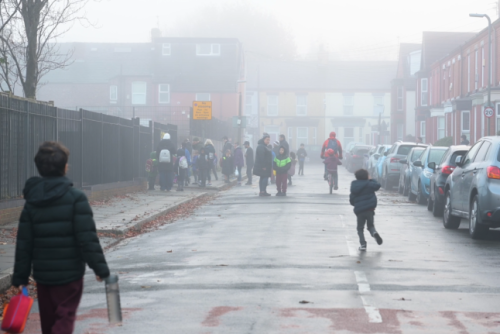Local authorities encourage adoption of School Streets to reduce traffic dangers

North West local authorities are increasingly engaging with the option of introducing ‘School Streets’ to reduce dangerous road conditions around their schools.
In most cases, a School Street consists of a range of measures outside to limit traffic during drop off and pick up time and create a pleasant child-friendly environment when the school gate is busiest.
Measures can include the option to issue fines to motorists flouting the restriction times, through the use of CCTV cameras.
Last month Greater Manchester’s active travel commissioner, Dame Sarah Storey, joined forces with the region’s mayor, Andy Burnham, to urge schools to develop their own School Street plans.
Andy Burnham’s most recent manifesto included an aim to boost the existing number of School Streets from 30 to 100 in the next four years.
Under new proposals, £1.3m will be invested with local authorities to develop the School Streets programme further, where School Streets can be made permanent, and be part of a range of interventions to ensure safer travel to school.
Dame Sarah Storey said: “Safety and convenience are two of the main barriers to people choosing to walk, wheel or cycle to school and interventions like School Streets are a good starting point for improving the whole journey for those travelling to school and onward about their day.
“Generating a focus on school travel is so important so that whole journeys can be catered for, and people given a genuine choice and alternative to having to use their car for the school drop off and pick up.”
Schools in Liverpool are also adopting the idea and the council is supporting schools to set up 50 School Streets over the coming years.
Cabinet Member for Transport and Connectivity, Cllr Dan Barrington, said: ”For a number of years we’ve been committed to bringing School Streets to Liverpool. Earlier this month we announced that camera enforcement will be coming to six more locations and we have ambitions for many more.
“As we know, every road user should follow or be aware of, if they are pedestrians, the Highway Code. But this is often far from reality and at busy times of the day particularly around schools this disregard for the rules of the road runs a real risk of a tragedy.”
He added: “So it was great to hear earlier this week that the Government has issued new national guidelines to help schools and councils deliver more School Streets.
“These were launched by National Active Travel Commissioner, Chris Boardman, at COP29 in Baku which underlines that the government sees them as a useful instrument in its environmental tool box.”
One of the earliest adopters for a School Street in Liverpool was Greenbank Primary. The school endured issues for many years with careless and potentially fatal behaviour from drivers.
Despite teachers’ best efforts to encourage better behaviour little changed and the school approached the council about a School Street which its Highways Team was happy to support.
Now, Arlington Avenue, next to the school, is free of through traffic for two hours a day, an hour at drop-off and pick-up times.
The school said the measures have made a huge difference, for the children and their parents, for teachers, and for residents who live in the terrace of houses which face the school on the road.








